Don’t Throw Away Those One-Yen Coins!
Top photo: FRANK211さん on PhotoAC
I studied abroad in Japan when I was in college, and when my studies concluded I packed my things and took everything home with me. Everything I wanted, that is. I left one thing in my room: a bag full of one-yen coins.
One-yen coins are the smallest yen and have the least value. They seemed worthless to me and I didn’t know what to do with them. They made my wallet bulge and I didn’t want them, so I discarded them. There are others in Japan who feel the same way I felt. My Japanese mother-in-law has a jar full of one-yen coins that she has collected over the years.
If you are coming to Japan and you are someone who usually shops with a debit or credit card, one thing you will have to get used to is using Japanese cash and coins. Although cashless options are increasing in Japan, the country has traditionally been a cash-based society, which means that you should always carry yen with you. When you do so, I suggest you take those one-yen coins with you, too.
When you are shopping in Japan, your goal should be to minimize your change. By doing some simple math in your head, you can give the cashier an amount that will get you the change that you want.
Say you are shopping at a super market and you have 1,758 yen in your wallet. Your total is 208 yen. The easiest way to pay that is to ignore your change purse and give the cashier 1,000 yen in cash. But, then your change is 792 yen and you have a handful of unwanted coins. So how can you pay for this to minimize your change?
Pay the exact amount:
Paying the exact amount is always preferable, because it means no change!
Pay the same as the ones amount:
Paying an amount greater than the total that has the same ones value will always give you good change. In this example, if you pay 508 yen, your change will be 300 yen.
Aim for a five-yen coin:
Something I do often when shopping is look at the total price and count the difference between the ones value and five. So, if the total is 208 yen, 8-5=3, and that means if I give 253 yen my change will be 45 yen.
These three methods are simple and will minimize your change and help you avoid those dreaded one-yen coins. There are other calculations, such as aim for a fifty-yen coin or aim for a five hundred-yen coin, that will help you with that. I’m still learning myself and hope to become a master at getting five hundred-yen coins. I’d love to fill a bag with those!
So, if you’re coming to Japan or are new here, make sure to carry yen with you everywhere you go, even those one-yen coins, and aim to pay an amount that will give you the change you want.
Photo Credits:
Top photo: FRANK211さん on PhotoAC
All other content (text) created by the original author and © 2023 MUSUBI by Borderlink
Top photo: makoto.hさん on PhotoAC
Arima, December, 1999. I’m about to embark on an experience that I’ve never taken before and to be brutally honest, I’m as nervous as hell!
Going to take a bath at a local hot spring seems mandatory to most common Japanese folk, however to a thirty years old Englishman, (as I was then) whose parents hail for Jamaica, a country well known for their conservative attitudes towards nudity, exposing myself to a bunch of Japanese males seemed daunting.
Arima is a small mountain side town located just a few miles away from the city of Kobe. It is one of the most famous hot springs in the area of Kansai, if not Japan. I arrive there with my wife, who was then my girlfriend and her mother.
On the way there, Kazumi my wife’s mother kept on going over the finer points of onsen manners much to the annoyance of Mayumi my wife, who keeps on saying leave him alone, leave him alone. Anyway, we get there and outside is cold!
There are a number of people in front of us, but it isn’t too long before we enter the establishment. It isn’t as grand as my wife had told me about before. She was quick to add this was the local bath run by what I would expect to be the council and it only cost 500 yen mind. That’s a lot cheaper than the fees the hotels charge in the area.
So, I get undressed and I feel like everyone is watching me, well at least everyone in the changing room. Most people there were older than me. I was far to busy washing and scrubbing myself to pay them any mind and I wanted to make sure I was as clean as I could be considering that your body has to be clean before climbing into the tub.
It was a bit hot to begin with, but as I relaxed and laid my head back, I started to say to myself, “this feels bloody good”. The big event was yet to come, as five minutes after I had sat myself down in the boiling water, some old boy who had, umm likely never seen a foreigner before in his life tripped up on the edge of the spa and nearly fell face first into it. I was trying so hard not to laugh!
Fast forward to now and I’ve taken to public bathing like a duck to water. All the tension and angst that I felt when I went to take my first bath is way in the back of my mind. An onsen, spa, public bath or what have you is a great experience. I’m glad to say that I have been to all four major islands of this great nation, Shikoku, Kyushu, Hokkaido and of course Honshu, and I’ve managed to take a bath on all for occasions.
I would love to give you some tips, but then I’d sound like my mother-in-law. What I would like to share with you are some of the amazing places you should see. Osaka may be the stand out city in Kansai or indeed western Japan, but it isn’t that great for famous hot springs. I’ve already mentioned Arima up in Kobe.
How about farther afield in Kinosaki, the far north of Hyogo. It’s a beautiful place which is perfect whatever season you choose to go there. Ryujin in the middle of Wakayama is an onsen town within a forest. It’s marvelous but not so easy to get to. Shirahama is another onsen resort in Wakayama which is has many places to have a soak although you want to avoid going there during the summer as it is very hot and crowded.
It happens to double as the most popular beach resort too. If you really want to go further but not so far as to jump on a plane, get on a bus at either Osaka or Kobe take a long ride across the longest suspension bridges in Japan and make your way to Iya-onsen on the beautiful island of Shikoku. The views are mystical and the baths are great.
I’ve been to my fair share of onsen both near and far. I can only say that each new one I go to makes me feel better and strengthen my idea that you’ll never find a better way to relax!
Photo Credits:
Top photo: makoto.hさん on PhotoAC
All other content (text) created by the original author and © 2023 MUSUBI by Borderlink
Top photo: 紺色らいおんさん on PhotoAC
So you have lived in Japan for a while and have been lucky enough to have met someone. You are getting tired of living in your micro-apartment with paper-thin walls. You talk with each other and decide to buy a house. If you’re going live in Japan for an extended period of time, and you are ready to move on from the life of a renting, it’s time to go big. Let’s go buy us a house!
Where to live (and who to talk to about it)
First thing you want to do is decide on which part of the town or city you want to live in. You think about the schools in your area, how convenient the location is and maybe how close to work you want to live. In my case, it was about being close to my wife’s family. We live a 5 minute walk from the train station, so that makes it easy to get back and forth to Okayama City. Then you need to decide on whether you want an older house or to build one from the foundation up. We decided we wanted a new house. A fresh start, after all.
The next step is to find a realtor. This is fairly easy: ask friends and do some research online. Realtors are always having an open house that you can go to and check out what the homes look like. The realtor we chose had several model homes behind their office, so we were able to choose pretty quickly.
Then you go into the office and talk about location, basic finances and a lot of small talk so you can get to know each other. If you decide to go ahead and buy the house, you’ll do some paperwork and pay a small fee to get the ball rolling. Now the real fun begins.
What you need (hint: it involves money)
Now you need to get all your personal paperwork ready like your passport, reisdence card, proof of residency, and if my memory serves me correctly, some paperwork from your company. I’m sure there was a lot more that my wife took care of. Next, you need land to build your house on. My wife’s family had land, so luckily we didn’t have to go through that process.
However most in this situation won’t have land available, so the realtor will take you to different lots in the area that you are interested in, and you can decide from there. Now that you have your ideal location with your ideal model home, it’s time to see about financing. This process seems to take forever, because there is so much paperwork to do.

Think of it this way: you’re laying the foundation of your new home!
The writing has to be perfect on this paperwork, no mistakes, otherwise you have to redo everything. Then it’s just a waiting game until they either approve or disapprove your loan. Unlike the United States, there is no credit rating in Japan, so your credit doesn’t mean a thing.
Congratulations, your loan has been approved. First thing before the building starts is that the realtor is going to check your land out. They are looking at the size of the plot, if it has a well and the location of the septic tank so they know how to build your house.
Right before construction begins you buy some gifts and meet the neighbors to explain that there will be construction going on for the next few months, and hope they understand. Some fancy, tasty treats always help to sweeten the deal.
How will it look?
The next big step is going to the realtor’s and discussing how you want the house to look. This includes colors of the floors, walls, types of doors, kind of lights. Everything you can think of you will decide the shape, style and color of. This seems to take days, but it’s just several hours of talking.
After that the foundation gets laid and a priest will come and have a blessing ceremony (an essential part of construction in Japan). Before you know it, construction will begin, and the house will be finished. Time to move in!
You now have your own home, an exciting and scary prospect at the same time. Everything is finished, you have furniture in every room, appliances in the kitchen, and a new sense of being. You can now do as you wish. Do all the things you could never do with an apartment. Plant flower gardens, decorate for the holidays, have friends over for a BBQ and smile as you look out your back door. It’s your house to make into your home.
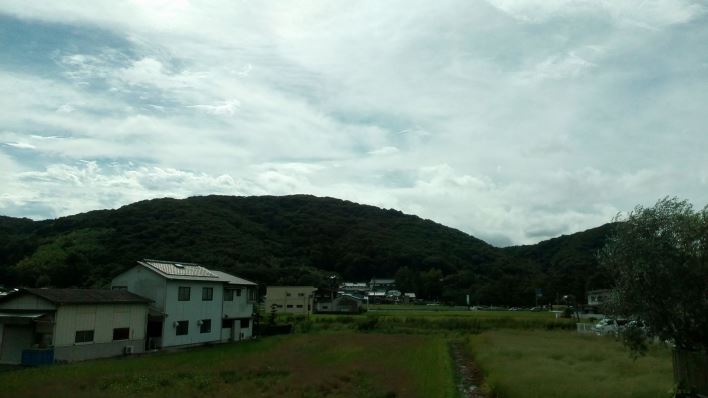
There’s no place like it!
Photo Credits:
Top photo: 紺色らいおんさん on PhotoAC
All additional images taken and provided by Jason Killingsworth, used with permission.
All other content (text) created by the original author and © 2023 MUSUBI by Borderlink
Top Photo: croissant.さん on PhotoAC
“It’s a dangerous business… going out your door. You step onto the road, and if you don’t keep your feet, there’s no knowing where you might be swept off to.”
Okay, so maybe not everyone reading this is a Lord of the Rings geek like me, but I think it’s safe to say that this quote encapsulates life in Japan for the vast majority of us ALTs living abroad. From the very moment I stepped onto Japanese soil, my life has been an exciting, unpredictable adventure that continues to stimulate my growth as an educator, student, and perhaps most importantly: as an individual.
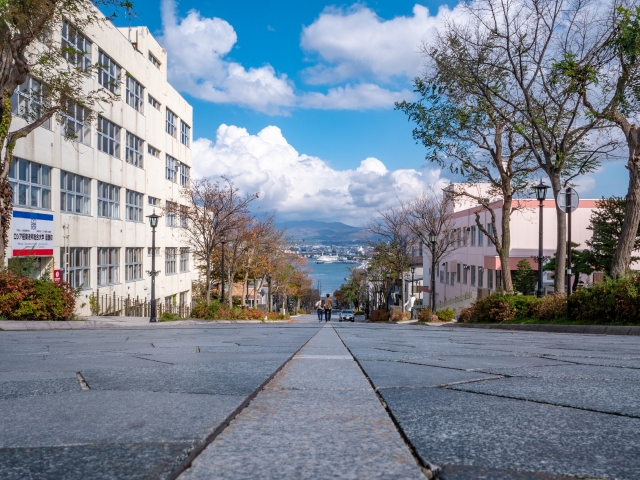
Photo by サヤキさん
It is my sincere hope that you will find this article to be more than just a collection of my thoughts and personal experience. While there have been many incredible articles written about the various places to visit in Japan, the foods to try, or the activities you can experience, I hope to offer you a reflection about the various ways in which living abroad can enrich your life and change your perspective about the world we live in.
My first official day in Japan was certainly one to remember as I’m sure many of the ALTs you’ll meet will attest to. As I left the airport and made my way to the train station, I suddenly found my phone without service.
I arrived at the Hamamatsucho station without access to my GPS, calls, texts, or internet. I found myself feeling overwhelmed by the hustle and bustle of Tokyo commuters, my lack of proficiency in the Japanese language, and of course my inability to use my phone that we, as a society, rely so heavily on.
After about an hour of using what little Japanese skills I have to ask for help, I found a kind, young woman, who helped me to call a cab and get safely to my hotel accommodations. My intention in sharing this story, is not to frighten or scare you off from coming to Japan. For me this experience will become a treasured memory marking the start of my time in Japan.
From the kindness of the stranger I met, who helped me get safely to my destination, to the confidence I gained in having to navigate Tokyo alone without the help of smart phone technology, I confirmed to myself the subtle yet powerful inner strength that each of us possesses.

Photo by sawadyさん
I’d like to say that every day since my first experience in Japan, has been smooth sailing, but I believe that would be an injustice to not only my own, but also to the many ALTs who have overcome the obstacles that come along with living abroad.
Before I go any further, it’s necessary for me to say that life in Japan is filled with amazing people, beautiful scenic nature, exciting places, and of course some of the most delicious food you will ever try, however, I think that the difficulties play an integral part in the incredible adventure of life in Japan.
The life of an ALT is one filled with so much excitement. While it’s true that we have earned the title of educator, it’s equally true that we too are students here in Japan. Every day I learn something new from the people around me. Perhaps my most important teachers have been the very students I teach each day.
I’ve learned that communication is more than simply language. While it’s true that language is one of the most important facilitators we have in building relationships, I’ve learned that its not the only way that we can communicate and create lasting friendships.
When I interact with my students each day, they remind me of this important fact. The children I teach approach me with such openness and desire to communicate. It’s beautiful and humbling to see how much effort they will put in to include me in their games of onigoko or dodgeball despite the language barrier we share. Every recess, I become a participant in their games, a member of their social circle, someone they can laugh with, someone they can share in the same experience with.

Photo by mascoccoさん
As an ALT in Japan, I believe your perception of communication and friendship will change tremendously. You will experience life in a way you have never experienced it before. You will witness the profound beauty in discovering how similar we as human beings truly are.
For those of you who have yet to come to Japan, I’d like to encourage you to continue your pursuit of living and working abroad in Japan! If you have the passion to come in Japan, I can say with confidence that this experience truly will be once in a lifetime.
You will find yourself learning new perspectives about life, about communication and friendship, and about yourself. You will face difficulties at time, but these obstacles will provide you with an inner strength and confidence that will remain with you for the rest of your life.
Ready to begin your ALT adventure? Apply now for an April 2023 start if you’re in Japan, or later in 2023/early 2024 if you’re overseas!
Photo Credits:
Top Photo: croissant.さん on PhotoAC
All other content (text) created by the original author and © 2023 MUSUBI by Borderlink
Top Photo by Bruno Aguirre on Unsplash
Last time, we covered the basics of kimono and how you can in fact rent them to wear for yourself when wandering about Kyoto. This week, I shall finish off my tale by telling you about the experience itself.
So, let’s rent that kimono
First, we looked for a reasonable rental shop as we both wanted to experience wearing kimono. Kyoto, being a famous tourist destination where one can stroll around wearing traditional attire, is rife with shops. However, every shop had nearly the same price range, which was quite expensive. The pricing was charged on the basis of rental hours.
For instance, for two hours (the minimum duration offered) and for two people, we paid around 7000 yen including tax. Generally, renting a whole kimono set may cost up to 3500-4000 yen. The cost of women’s kimono sets are a little higher than men’s as it includes an optional hairdo styling. But for a once-in-a-lifetime experience, I feel it’s worth paying for.
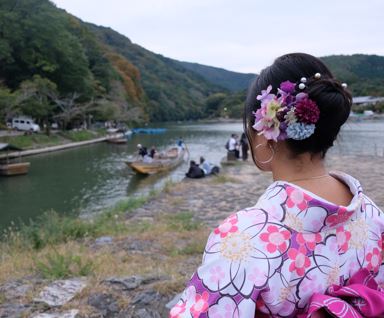
Picture taken with my Kimono hairdo.
Now, to say how a kimono is worn is the most difficult part, as only professionals or someone of the older generation can explain it better. Due to the complex process of correctly wearing a kimono and its high pricing, kimono culture is not seen as a common phenomenon in recent years among the younger generations. But there is a specific method to it.
First, we chose our respective kimono in the shop. I was flabbergasted at viewing their awesome collections. We got matching geta (traditional wooden sandals) and unique silk clutch bags. We were asked to hand over our belongings- jackets, shoes, luggage etc. Don’t worry, this is normal- it’s essentially like a security deposit, and everything was kept safe until we returned the rented kimono sets. In some shops, there can also be a deposit fee which is then returned later. I remember then entering a room in the shop where there were almost 5-6 professional lady dressers who were dressing up other tourists (men and women will have different dressing rooms).
When I finally had the chance to wear a kimono!
Before entering the room, we had to take off our shoes and place them on a shelf, then receive a token. The changing room was a spacious room with mattresses on the floor, all covered with super white bed sheets. There were big mirrors on the walls, as well as a wide collection of colorful hairpins and flower accessories. Some staff were arranging the already returned kimonos. Others were doing the hairdos. Two ladies with utmost hospitality and smiling faces came over to me to dress me up.
Altogether, I was wrapped with almost four layers of cloth pieces, the third being a cotton inner jacket. On top of that I wore a huge cloth which was the final piece of kimono with the ultimate silk fabric work. After wearing the final layer of the clothing, I was then tied with the colorful belt or obi that completed the look. This then followed a beautiful hairdo where I chose the hairpins myself to match with my kimono. Lastly, I put on the geta. As I mentioned previously, men’s kimono tend to be lots of solid colors. My husband wore a plain maroon-ish kimono, got a kimono bag, his pair of geta, and we were all set for the stroll.
And the moment we walked out onto the Arashiyama streets of Kyoto, it was one of the most incredible experiences I have ever had. Because of this memory, Kyoto has forever taken a soft spot in my heart. I can say, without a doubt, you should never miss the chance to wear a kimono when you visit Japan, especially if you’re going to be in Arashiyama or the Gion district of Kyoto. Tokyo has kimono rental shops as well, especially around Shibuya. But Kyoto is where it will feel the most authentic as you stroll amidst the buildings of antiquity and the bamboo forests.
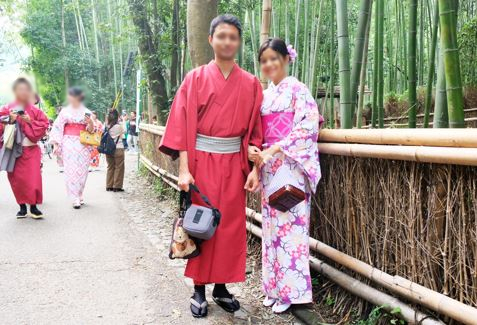
Photo taken by a random tourist in Arashiyama Bamboo forest, Kyoto
Now, how much does it cost to buy a kimono?
Sometimes I will randomly stop by a kimono store at malls. I don’t ever dare to go inside though, as you can probably guess by now that these things are not cheap. Kimono prices generally range from about 20,000 yen to over 500,000 yen and beyond for the high-quality stuff. Shocking, I know! In fact, there are no fixed prices for kimono; as it depends from store to store. Apart from the kimono cost, the obi/belt likely has to be purchased separately, which can be anywhere from 10,000 to 100,000 yen itself. Hence, buying a kimono is a really hard nut to crack.
However, there is a way to buy and wear something in place of kimono that also represents a great symbol of Japanese tradition and culture: The yukata. Yukata are just the summer version of kimono, made of cotton, polyester or linen. They are easier to wear and also affordable to buy. In fact, they are often complementary at traditional inns (to wear there, not keep!)
So, if you happen to visit Japan and want to buy a kimono as a sign of Japan, you can go for a yukata instead. These are readily available in malls and stores, and usually found in the range between 3,000 yen to 10,000 yen. A high-end yukata is about the same as a low-end kimono, think of it that way.
Conclusion
I hope you have enjoyed our trip through the world of the stunning traditional clothing of Japan, the kimono. Even if you can’t buy one, know that they are available for tourists rent, wear and stroll around beautiful places in. Wearing it and posing for photographs gives one a strong vibe and even what feels like a deeper understanding of Japanese culture. Well, this is just one aspect of that culture that I have shared with you all. I hope in the near future, I can share more of my experiences in this amazing country!
Photo Credits:
Top Photo by Bruno Aguirre on Unsplash
All additional photos provided by Anmona Handique, used with permission
All other content (text) created by the original author and © 2023 MUSUBI by Borderlink
Japan has always been known for its rich cultural aspects, be it age-old traditions or the hues of contemporary modern society. Today, I would like to introduce you to a very special area of it that forms one of the integral parts of Japan’s cultural heritage. This is something I have long heard of or seen from a distance. I finally had the experience of trying it for the first time during my trip to Kyoto in October 2019.
Every autumn in Japan you can enjoy the Momiji (viewing of autumn leaves). During that particular autumn, my husband and I visited the cultural capital city of Japan. I can still recall the most pleasant weather as we basked in the bright and sunny autumn sun, accompanied by the beautiful autumn breeze. Despite the fresh aura, the autumn fall foliage was not yet out to shower its love across the city. Surprisingly, in lieu of that, we got to explore something even more exciting and overwhelming.
So, what is this all about?
I would like to talk about experiencing one of the exquisite elegances of Japanese traditions and culture, known as ‘kimono’. I’m sure that this term is not unfamiliar when it comes to Japan, right up their marvelous ‘sushi’ dishes and ‘samurai’ history. As such, much before I had come to Japan, I too had heard about the famous kimono and had a fascination to see the Japanese wearing kimono.
But incredibly, I never imagined myself putting it on, and walking in the streets of Japan. I feel really blessed and lucky that I got to experience that one special moment wearing the gorgeous kimono along with locals and tourists alike.
With my little knowledge and experience about kimono, through this article, I would briefly like to give you a small picture about some basic nuances of the stunning traditional Japanese attire. For instance, what these kimono is all about, when it is worn, the system of rental shops and their charges, what comes along with the Kimono attire, their usual price range, and how these Kimono differ from yukata (another traditional Japanese attire much similar to kimono).
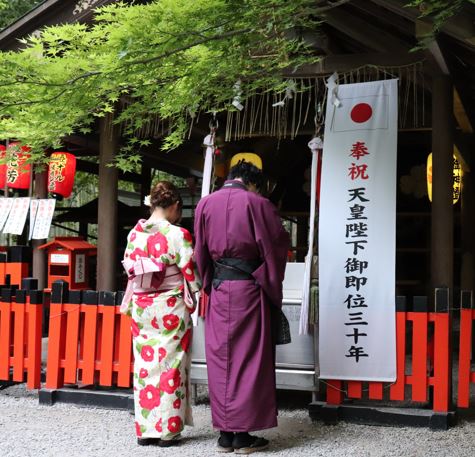
Photo by Tathagat Mahanta
So, what is a kimono?
The word kimono means a traditional Japanese garment where ki means ‘to wear’ and mono means ‘a thing’, i.e., a thing to wear. They are made from a single length of cloth called tanmono which is 36-42 cm in width and around 12 meters long. It is mainly silk, which is used as a common fabric in the traditional kimono. Depending upon the type of silk, there comes a difference in the price range.
Modern kimono also use various kind of other fabrics such as cotton, linen, polyester etc. Although kimono are for both men and women, they are most popularly seen as a fascination among Japanese women. Typically, men’s kimono are designed with solid patterns that are usually available in single colors.
By contrast, women’s kimono are made to be very attractive with different colorful designs aligning to different seasons of the year. What I have noticed is that young girls are often seen wearing a kimono mainly during particular events or occasions, and not like the daily attire which it once used to be. It is said that it was only after the 20th century that kimono culture began to fade.
It is all about the style and unique designs of the kimono that symbolizes its glory. Different silks in different regions of the country are used to make them, further giving the kimono a unique touch. I feel, much like our traditional Assamese Mekhela Chadar of Assam, India, the beauty of kimono is also symbolized mainly by the different styles and patterns, color, motifs and the materials used in making it.
Well now, if you’re wondering about what and where Assam is and why I’m relating it to Japan, it’s because I’m a native from Assam, the north-east region of India. Like Japan’s kimono, Assam’s prestigious and culturally rich attire is the beautiful Mekhela Chador. However, if you want to know more about Assam, don’t hesitate to Google it!
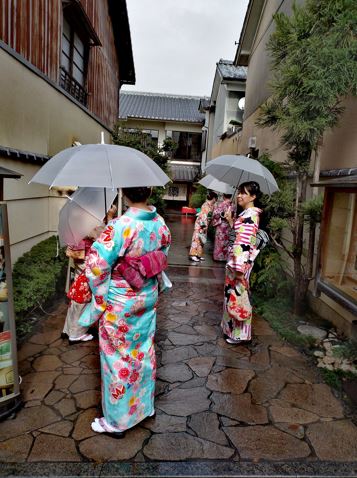
A group of Japanese women strolling on the Kyoto streets.
What as a tourist you can learn about kimono?
From the little research that I have done, there are different types of kimono that are worn on the basis of different occasions and seasons. For instance, the kimono that I wore falls in the category of Furisode (in Japanese). These kimono are usually seen worn by young girls and tourists who can rent them. They have the longest sleeves, with beautiful colored motif designs all over, and are tied with bright belts (obi in Japanese).
Likewise, there are formal (worn for weddings & traditional ceremonies), casual (known as Kumon in Japanese), and non-wedding, semi-formal (worn for tea ceremonies) kimono that Japanese wear as per their respective occasions and traditions.
The kimono are mainly hand-sewn into a T-shape comprising of four different pieces of fabric and tied with n obi and other accessories. The basic set of a kimono includes the following- zori (formal flat sandals), geta (open wooden shoes with a raised platform), tabi (white socks), obi (Kimono belt), kanzashi (decorative floral hair-pins), haori (traditional open jacket), kimono silk clutch bags and bangasa (traditional umbrella).
In our case, we opted to wear geta and took the entire set except haori and bangasa. Yes, it is not required for the tourist to take the entire kimono set; it is completely optional as different pieces have a different price.
Next, I’ll tell you about our experience renting (and walking about) in kimono…
Come back next Tuesday for the conclusion here on MUSUBI!
Photo Credits:
All additional photos provided by Anmona Handique, used with permission
All other content (text) created by the original author and © 2023 MUSUBI by Borderlink
Top photo: けいごkeigoさん on PhotoAC
Are you up all night planning your trip or journey to Japan? Being one of the wealthiest and most prosperous countries in the world, it is not a shock that so many people want to come and explore Japan. Before leaving your homeland and becoming a wanderer in this wonderful place, there are some things that you should prepare ahead of time to avoid stress. Ensure the smooth sailing trip that you’ve always dreamed of! What are these things? Here are my Top 5!
1. Get a Suica or a Pasmo IC card


What are IC cards? These are electronic money cards that are mostly used for train stations or cashless shopping experiences. All you have to do is tap this magic card and you’re good to go! You don’t need to purchase a separate ticket when going on the train lines. Sounds like you can save a lot of time and energy, right? Just don’t forget to reload it before boarding in (easily done at almost any ticket machine in majors stations). Suica and Pasmo are the most popular in east Japan, but be aware that west Japan uses Icoca (which usually won’t present a problem, except with certain local trains of buses that only take one specific kind). There are also mobile app versions you can download direct to your phone.
2. Purchase an internet or data SIM card
This is a must! If you don’t want to find yourself all night looking for your accommodation or suddenly lost on the many train lines, you must buy this one before starting your journey. You can find SIM cards like this in airports, or even online. This is also very helpful when you can’t speak the language and in sudden need of Google Translate to communicate with the locals. If you’re planning a more long-term stay in Japan (as in, to live and work!) changing over the SIM card of your current phone or purchasing a new phone in Japan are absolutely things you should be doing.
3. Try capsule hotels

Photo by MEB
If you are on a budget, this hotel unit might be for you! Instead of renting a full hotel room or an Airbnb, a budget-friendly capsule room is a top pick for solo travelers. A spacious single bed, sometimes with your own television inside. It also comes with a pretty decent shared shower room and lockers to keep your stuff safe and secure. Though depending on the location, it usually ranges from ¥1,800 ~ ¥3,000. A great deal, huh!
4. Learn the basic Japanese expressions
Speaking of communication, even though Japan has some of the most advanced technology in the world, many locals cannot speak more than the bare minimum of English. It will be very helpful if you can speak some basic expressions like “Arigatou gozaimasu”, “Konnichiwa”, “suimasen”, or the most important one of all: “toire wa doko desu ka?” (Where is the toilet?)
5. Don’t tip!

Photo by webbiz
You might have gone through many foreign countries where tipping is loved by the majority of the staff, but Japan is not of them. Japanese people have “omotenashi culture” where customers are always given great service. It is normal in Japan to give this kind of service to their customers; that is why a simple “thank you” is considered enough. You might be a little worried that things may not come up as what you expect them to be, but just like Seth Godin said, “if it scares you, it might be a good thing to try”. (Also, the lack of a tip is offset by a higher minimum wage, and overall prices for goods and services. You don’t need tip for a pizza delivery when the pizza is almost 4,000 yen!)
Photo Credits:
Top photo: けいごkeigoさん on PhotoAC
Additional photos by MEB and webbiz
All other content (text) created by the original author and © 2023 MUSUBI by Borderlink
Top Photo: _musubiさん on PhotoAC
Just in time for Setsubun, here are some delightful Japanese sweets to try!
Craving for sweets, but looking to try something new? How about some of these traditional Japanese sweets, or wagashi.
Growing up as an avid anime watcher, I saw a lot of interesting and unique Japanese sweets that made me want to visit Japan and try them myself. And from the time that first did, I fell in love with the various flavors of Japan’s traditional snacks and dessers. Here are some of my favorites:
Mochi
The very origins of Japanese sweets can be traced back to mochi, the sticky rice cake that is considered Japan’s oldest processed food. Mochi gets its name from its main ingredient, mochigome rice (a short-grain, glutinous type of rice). This gives mochi its distinctive gooey texture after it has been sufficiently mashed and pounded.
Mochi is frequently consumed during holidays, special events and other occasions. It has been a part of Japanese New Year celebrations since the Heian period. Mochi-pounding itself is frequently a part of holiday festivities, if not the focus of a special event itself. Long story short, mochi is as synonymous with Japan as sakura, haiku and kimono.
Mochi can be served either savory or sweet. It comes in a variety of flavors, including daifuku (a rice cake filled with red bean paste), kusamochi (a rice cake flavored with Japanese mugwort) and sakura mochi (a rice cake wrapped in a salted cherry blossom leaf).
Dorayaki
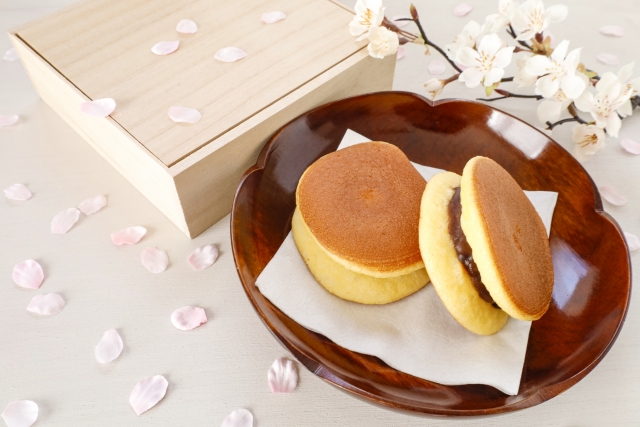
Photo by hana+choco
Created in the early 1900’s by a Tokyo dessert maker, Dorayaki is a popular Japanese sweet among Japanese people of all ages even today. It is perhaps most well-known as the favorite snack of the popular manga and anime character “Doraemon” whose name derives from the sweet. To make Dorayaki, two small pancakes act to sandwich red bean paste. Other fillings like custard cream and chocolate can be used, making this a multi-purpose confectionary.
Manju
Manju are sweet pastry cakes, made of steamed dough, and filled with sweet bean paste. Before baking or steaming, manju are formed into a variety of shapes, ranging from perfectly round cakes to pointed chestnuts. Aside from sweet bean paste (anko), they can also have other flavors such as green tea (matcha), milk, and white kidney beans.
Dango
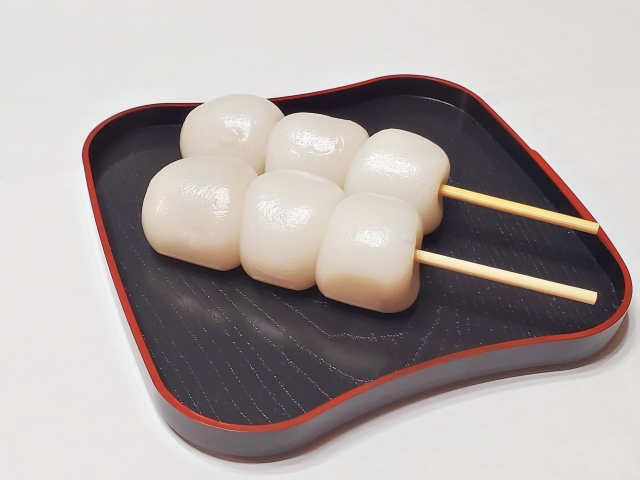
Photo by 乙樹
Whereas mochi is made from pounded rice, dango are small dumplings made from sweet rice flour. The rice flour is mixed with hot water to make dough, which is then formed into the dumplings that are boiled, skewered, and grilled. This results in them having a slightly chewier texture. Dango are delicious plain or drenched in thick, sweet soy sauce. Sesame seeds are frequently added to rice flour to create a nuttier-tasting “goma-dango.”
Senbei
Senbei are toasted rice cracker snacks. They can have a wonderful aroma and a crisp texture after being freshly roasted over charcoal. Unlike many other types of wagashi, these are made from non-glutinous rice rather than the sticky kind. Thus they will always be crispy and crunchy, no matter the variation. Senbei can be flavored with soy sauce, sesame seeds, sugar, and nori seaweed.
That’s just scratching the surface of the many traditional Japanese sweets you’ll find. If you live in Japan or plan to visit, don’t miss out on these delectable and savory treats. They will surely sweeten up your day!
Looking for some places in Tokyo to find Wagashi? Check out our guide here!
Thinking of moving to Tokyo, Osaka, or one of the other major areas in Japan for work as an Assistant Language Teacher? See the many options starting from April 2023!
Photo Credits:
Top Photo: _musubiさん on PhotoAC
Additional photos by hana+choco and 乙樹
All other content (text) created by the original author and © 2023 MUSUBI by Borderlink
